Tomato (Lycopersicon esculentum Mill.)
Solanaceae
| Varieties
PKM 1,CO.1 ,CO.2 ,CO.3 , (Marutham) and Paiyur 1
Hybrids
COTH.1 ,COTH 2 and TNAU Tomato Hybrid CO 3
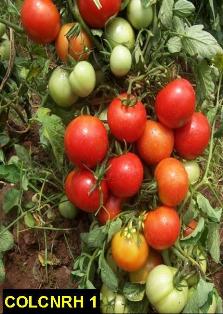 |
TNAU Tomato Hybrid CO 3:
It is a hybrid between HN 2 x CLN 2123A. Yields about 96.2 tonnes/ha in a crop duration of 140-145 days. Plants are semi determinate (90-95 cm) and suitable for high density planting .Fruits are smooth round, medium sized, and borne in clusters of 3-5.
High yielding and resistant to leaf curl virus disease and moderately resistant to root knot nematode |
|
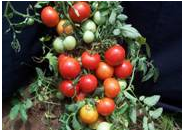
|
COTH2 (2006):
It is a hybrid between LCR 2 and CLN 2123A. It has resistance to leaf curl virus disease and without pesticide spray it recorded a yield of 90.2 t/ha under normal conditions. Fruits are smooth round to slightly oblong, medium sized; unripe fruits whitish green, ripe fruits bright red coloured and borne in clusters of 3-5. |
| |
|
|
|
|
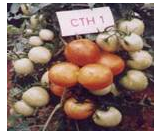 |
COTH.1 (1998):
It is a hybrid between IIHR 709 x LE.812. Yields about 95.9 tonnes/ha in a crop duration of 115 days. Fruits are acidic (0.61%)
|
|

|
PKM 1:
It is an induced mutant from Annanji.Fruits are flat round with prominent green shoulder and suitable for long distance transport. Yield is 30-35 tonnes/ha in a crop duration of 135 days. |
| |
|
|
|
|
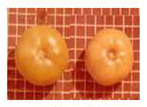 |
CO.1 (1969):
Reselection from Kalyanpur selection. semi determinate variety, fruits are round without any grooves and crimson red in colour. Yield is 25 tonnes/ha in a crop duration of 135 days
|
|
 |
CO.2 (1974):
Selection from Russian introduction. Indeterminate variety with an average fruit weight of 50-60g.eruits are flat with 4-5 furrows. Yield is 28-30 tonnes/ha in a crop duration of 145 days. |
| |
|
|
|
|
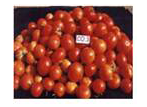
|
CO.3 (1980):
Induced mutant from CO1;a determinate variety suitable for close planting (30x30cm).i t is a cluster bearing type yielding 40t/ha ia a duration of 100-105 days |
|
Paiyur-1:
It is a variety evolved by crossing PusaRuby and CO3.Suitable for rainfed cultivation. It yields about 30tonnes/ha. |
Soil
Well drained loamy soils rich in organic matter with a pH range of 6.5-7.5.
Season of sowing
May - June and November – December
Nursery bed preparation
Apply FYM 10 kg, Neem cake 1 kg, VAM 50 g, enriched Superphosphate 100 g and Furadon 10 g per square meter before sowing.
Seed rate
Varieties : 300-350 g / ha
Hybrids : 100-150 g / ha
Seed treatment
Treat the seeds with Trichoderma viride 4 g or Pseudomonas fluorescens 10 g or Carbendazim 2 g per kg of seeds 24 hours before sowing. Just before sowing, treat the seeds with Azospirillum @ 40 g / 400 g of seeds. Sow in lines at 10 cm apart in raised nursery beds and cover with sand.
Protected nursery
- Prepare the nursery area of 3 cents with slanting slope of 2 % for the seedling production to cover 1 ha.
- Cover the nursery area with 50 % shade net and cover the sides using 40/50 mesh insect proof nylon net.
- Form raised beds of 1 m width and convenient length and place HDPV pipes at 2m interval for further protection with polythene sheets during rainy months.
- Mix sterilized cocopeat @ 300 kg with 5 kg neem cake along with Azospirillum and Phosphobacteria each @ 1 kg. Approximately 1.2 kg of cocopeat is required for filling one protray. 238 protrays (98 cells) are required for the production of 23,334 seedlings, which are required for one hectare adopting a spacing of 90 x 60 x 60 cm in paired row system.
- Sow the treated seed in protrays @ one seed per cell.
- Cover the seed with cocopeat and keep the trays one above the other and cover with a polythene sheet till germination starts
- After six days, place the protrays with germinated seeds individually on the raised beds inside the shade net
- Water with rosecan everyday and drench with NPK 19:19:19 @ 0.5% (5g/l) at 18 days after sowing
Field preparation
Plough the land to fine tilth. Thoroughly prepare the field with the addition of FYM @ 25 t/ ha and form ridges and furrows at a spacing of 60 cm. Apply 2 kg/ha of Azospirillum and 2 kg/ha of Phosphobacteria by mixing with 50 kg of FYM. Irrigate the furrows and transplant 25 days old seedlings on the sides of ridges. Life irrigation to be given on 3rd day of planting.
Spacing for varieties
PKM 1, Paiyur 1, COTH 2, TNAU Tomato Hybrid CO 3 : 60 x 45 cm
CO 3 : 45 x 30 cm
Mulching
Mulch with black LDPE sheets of 25 micron thickness and bury both the ends into the soil to a depth of 10 cm
Weed control
Apply Pendimethalin 1.0 kg a.i./ha or Fluchloralin 1.0 kg a.i / ha as pre-emergence herbicide, followed by hand weeding once at 30 days after planting.
Irrigation
After establishment of seedlings, irrigate at weekly intervals. |
Layout and planting for drip irrigation & fertigation
- Apply FYM @ 25 t / ha as basal before last ploughing.
- Apply 2 kg/ha of Azospirillum and 2 kg/ha Phosphobacteria by mixing with 50 kg of FYM.
- Apply 75 % total recommended dose of superphosphate ie 1172 kg / ha as basal.
- Install the drip irrigation with main and sub main pipes and place lateral tubes at an interval of 1.5 m.
- Place the drippers in lateral tubes at an interval of 60 cm and 50 cm spacing with 4 LPH and 3.5 LPH capacities respectively.
- Form raised beds of 120 cm width at an interval of 30 cm and place the laterals at the centre of each bed.
- Before planting, wet the beds using drip system for 8-12 hrs.
- Planting to be done at a spacing of 90 x 60 x 60 cm in the paired row system, using ropes marked at 60 cm spacing.
- Spray Pendimethalin 1.0 kg a.i. / ha or Fluchloralin 1.0 kg a.i / ha as pre-emergence herbicide at 3rd day after planting.
- Gap filling has to be done at 7th day after transplanting.
Manuring
Varieties
Basal dose : FYM 25 t/ha, NPK 75:100:50 kg / ha
Borax 10 kg and Zinc sulphate 50 kg / ha
Top dressing : 75 kg N/ha on 30th day of planting or during earthing up.
Hybrids
Basal dose : FYM 25 t/ha, NPK 50:250:100 kg/ha
Borax 10 kg and Zinc sulphate 50 kg/ha
Top dressing : N and K each 150 kg/ha in 3 equal splits at 30, 45 and 60 days after planting.
Fertigation schedule for tomato hybrids
Recommended dose: 200:250: 250 kg / ha
| Stage |
Crop stage |
Duration in days |
Fertilizer grade |
Total Fertilizer (kg/ha) |
Nutrient applied |
% of requirement |
| N |
P |
K |
N |
P |
K |
| 1 |
Transplanting
to plant
establishment
stage |
10 |
19:19:19
13:0:45
Urea
(46%N) |
65.78
27.77
8.44 |
12.50
3.61
3.88 |
12.50
-
- |
12.50
12.50
- |
10.00 |
5.00 |
10.00 |
| 19.99 |
12.50 |
25.00 |
|
|
|
| 2 |
Flower
initiation to
flowering |
30 |
12:61:0
13:0:45
Urea
(46%N) |
40.98
222.22
100.27 |
4.92
28.89
46.12 |
25.00
-
- |
-
100.00
- |
40.00 |
10.00 |
40.00 |
| 79.93 |
25.00 |
100.00 |
|
|
|
| 3 |
Flowering to
fruit set |
30 |
19:19:19
13.0:45
Urea
(46%N) |
65.78
138.88
63.90 |
12.50
18.05
29.39 |
12.50
-
- |
12.50
62.50
- |
30.00 |
5.00 |
30.00 |
| 59.94 |
12.50 |
75.00 |
|
|
|
| 4 |
Alternate day
from picking |
80 |
12:61:0
13:0:45
Urea
(46%N) |
20.49
111.11
50.14 |
2.46
14.44
23.06 |
12.50
-
- |
-
50.00
- |
20.00 |
5.00 |
20.00 |
| 39.96 |
12.50 |
50.00 |
|
|
|
| |
|
|
|
|
199.82
or
200.00 |
62.50 |
250.00 |
100 |
25 |
100 |
75% of RD of P applied as superphosphate as basal application= 1172 kg/ha
1. 19:19:19 = 132 kg / ha
2. 12:61:0 = 62 kg / ha
3. 13:0:45 = 500 kg / ha
4. Urea = 223 kg / ha
Growth regulators
Spray 1.25 ppm (625 ml in 500 litres of water) Triacontanol at 15 days after transplanting and at full bloom stage to increase the yield.
Training of hybrids
- Stake the plants 30 days after planting with 1 - 1.5 m tall stakes.
- Remove the side branches up to 20 cm from ground level.
Micronutrient spray
- Foliar spray of ZnSO4 @ 0.5 per cent thrice at 10 days interval from 40 days after planting.
- Spray 19:19:19 + Mn @ 1 % at 60 days after planting.
Protected cultivation
Production practices for cultivation of tomato under shade net
During summer, the hybrid tomato can be grown in a shade level of 35 per cent under paired row planting system (80 x 40 x 60 cm - between pairs, rows and plants) with a basal application of 50 kg each of N and K and 250 kg of P / ha and fertigation of 200 kg each of N and K through straight fertilizers.
Protected cultivation of tomato in polyhouse
During rainy season, the indeterminate tomato hybrid has to be grown in the medium consisting of FYM : composted coir pith: sand (2:1:1) with irrigation regime of 20kPa and basal application of 50kg each of NPK/ha as straight fertilizers and 250 kg each of NPK as water soluble and straight fertilizers through fertigation along with black polyethylene mulch (50 microns).
Plant Protection
Pests
Fruit borer
-
Grow simultaneously 40 days old American tall marigold and 25 days old tomato seedlings @ 1:16 rows.
-
Set up pheromone traps @ 12/ha.
-
Collection and destruction of damaged fruits and grown up caterpillars.
-
Release Trichogramma pretiosum @ 1 lakh nos. /ha/release at an interval of 7 days starting from flower initiation stage based on ETL of 10% damage.
-
For Helicoverpa armigera: HaNPV 1.5 x 1012 POBs/ha i.e. NPV of H. armigera 0.43% AS @ 3.0 ml/lit or 2 % AS @ 1.0 ml per lit
-
For Spodoptera litura: Sl NPV 1.5 x 1012 POBs/ha
-
Provide poison bait with carbaryl 50 WP 1.25 kg, rice bran 12.5 kg, jaggery 1.25 kg and water 7.5 lit/ha
-
Spray Bacillus thuringiensis 2g/lit or any one of the following insecticide
| Insecticide |
Dose |
| Azadirachtin 1.0 % EC (10000 ppm) |
2.0 ml/ l |
| Indoxacarb 14.5 % SC |
8 ml/10 l |
| Flubendiamide 20 WG |
5 g/10 l |
| Flubendiamide 480 SC |
2.5 ml/10 l |
| Novaluron 10 % EC |
7.5 ml/10 l |
| Phosalone 35 % EC |
13 ml/10 l |
| Quinalphos 20 % AF |
1.5 ml/ l |
| Quinalphos 25 % EC |
1.0 ml/ l |

Helicoverpa armigera
Serpentine leaf miner
Spray Neem Seed Kernel Extract 5 %.
Whitefly
1. Install yellow sticky traps @12/ha to attract the adult.
2. Remove alternate weed host Abutilon indicum
3. Apply carbofuran 3% G @ 40 kg /ha or spray any one of the following insecticides
| Insecticide |
Dose |
| Dimethoate 30 % EC |
1.0 ml/lit. |
| Malathion 50 % EC |
1.5 ml/ lit. |
| Oxydemeton –Methyl 25 % EC |
1.0 ml/ lit. |
| Thiamethoxam 25 % WG |
4.0 ml/10 lit. |
Nematode
Soil application of Bacillus subtilis (BbV 57) or Pseudomonas fluorescens as seed treatment @ 10 g/kg of seeds and soil application (SA) @ 2.5 kg / ha for the management root knot and reniform nematode infestation in soil and root. Application of liquid formulation of Bacillus subtilis (BbV 57) or Pseudomonas fluorescens @ 1000 ml/ha through drip irrigation for the management of root knot nematode in tomato.
Diseases
Damping off (nursery)
Treat the seeds with Trichoderma viride 4 g/kg or Pseudomonas fluorescens 10 g /kg of seed 24 hours before sowing. Apply Pseudomonas fluorescens as soil application @ 2.5 kg/ha mixed with 50 kg of FYM. Water stagnation should be avoided. Drench with Copper oxychloride at 2.5 g/lit at 4 lit/sq.m.
Leaf spot
Leaf spot can be controlled by spraying Zineb or Mancozeb 2 g/lit.
Fusarial wilt and Root knot nematode
Soil solarization before preparation of nursery bed. Seed treatment with Pseudomonas fluorescens (PF) @ 10 g /kg of seed, followed by nursery application of Pf1@ 20 g/m2 and seedling dip with Pf1 @ 5g/l along with soil application of Pf1 @ 2.5 kg mixed with 50 kg FYM /ha at 30 days of transplanting.
Leaf curl
Spray systemic insecticides like methyl demeton or dimethoate @ 2 ml/lit. to kill the insect vector, whitefly.
Tomato spotted wilt disease
Carbofuran 3 G @ 33 kg/ha in nursery at sowing and second application @ 40 kg /ha on 10 days after transplanting in main field and 3 sprays of phosalone 35 EC @ 1.5 ml/lit @ 25, 40, 55 days after transplanting.
 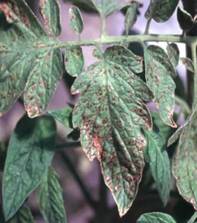
Tomato spotted wilt disease
Peanut bud necrosis virus
Selection of healthy seedlings and rouging of PBNV infected plants up to 45 days of planting. Apply Carbofuran 3 G 1 kg a.i./ha in nursery at sowing and second application at 1.25 kg a.i./ha 10 days after transplanting in mainfield and 3 sprays of Dimethoate 30 EC 1 ml/l or Methyl demeton 25 EC 1 ml/l or Phosphomidan 1.0 ml/l @ 25, 40 and 55 days after transplanting.
Duration
110- 115 days from transplanting (135 - 140 days from sowing)
Yield
Varieties : 30 - 40 t / ha
Hybrids : 80 - 95 t / ha
Boom flower - N spray at 2ml / litre in three sprays – 30 days, 55 days and 75 days after planting increase the yield.
IPM Package for Tomato
-
Seed treatment with Pseudomonas fluorescens @ 10g/kg of seeds
-
Nursery application with Trichoderma viride and Pseudomonas fluorescens
-
Application of Neem cake @ 250kg/ha
-
Soil application of Pseudomonas fluorescens @ 2.5kg/ha
-
Selection of good and virus disease free seedlings for planting
-
Roguing out of virus infected plants upto 45 days of transplanting
-
Grow marigold as a border crop
-
Set up Helicoverpa / Spodoptera pheromone traps @ 12 numbers / ha
-
Release Trichogramma chilonis @ 50000/ha
-
Install yellow sticky traps
-
Spraying Neem formulations (1%) / Neem seed kernel extract (5%)
Post Harvest Technology of Tomato:
Video for Dehydrated Tomato
Source
1. http://www.ikisan.com/Images/tom_im_tob.cater3.jpg
2. http://www.oznet.ksu.edu/path-ext/factSheets/Tomato/Tomato%20images/spotted wilttomato2small.jpg
3. http://msucares.com/newsletters/pests/infobytes/images/ghtswv1.jpg |










